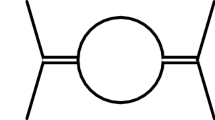Summary
Given the experimental data for low-energy π-N scattering in the (3/2, 3/2) state the threshold behaviour of the residue function (β) is deduced for the Regge trajectory (α) on which the (3/2, 3/2) resonance lies. In order to avoid a threshold infinity in the residue function a restriction must be placed on Reα evaluated at threshold. With the threshold behavior deduced for (β) a new effective-range formula is deduced for low-energy π-N scattering in the (3/2, 3/2) state. The analysis is based on the Khuri-Udgaonkar method for studying low-energy scattering of strongly interacting particles and can be extended to any resonant state where competing inelastic channels can be neglected.
Riassunto
In base ai dati sperimentali per lo scattering π-N di bassa energia nello stato (3/2, 3/2) si deduce il comportamento di soglia della funzione residua (β) dalla traiettoria di Regge su cui sta la risonanza (3/2, 3/2). Allo scopo di evitare un’infinità di soglie nella funzione residua si deve porre una restrizione a Reα valutata alla soglia. Dal comportamento di soglia dedotto perβ si ottiene una nuova formula del percorso effettivo per lo scattering π-N di bassa energia nello stato (3/2, 3/2). Lo studio è basato sul metodo di Khuri-Udgaonkar per studiare lo scattering di bassa energia delle particelle ad interazione forte e può essere esteso ad ogni stato risonante in cui si possono trascurare canali anelastici in competizione fra loro.
Similar content being viewed by others
References
N. N. Khuri:Phys. Rev.,130, 429 (1963). See alsoC. E. Jones: UCRL-10700 for an independent derivation of the new Regge representation.
N. N. Khuri andB. M. Udgaonkar: (to be published).
The justification for neglecting competing inelastic channels for π-N scattering in the (3/2, 3/2) state can be found in a recent calculation by Singh and Udgaonkar (Theory of the (3/2, 3/2) π-N Resonance, to be published inPhys. Rev.).
The derivation of (1) is very similar to the derivation of eq. (5) in reference (2). It appears to be a general rule — within the framework of reference (2) — that all resonating amplitudes have the form (1). The only difference is that the appropriate (α) and (β) must be inserted. This statement is not obvious and its justification is left as an exercise for the reader. It should be noted thatKhuri andUdgaonkar defined their residue with opposite sign.
I am indebted to Dr.V. Teplitz for raising this point.
G. F. Chew andF. E. Low:Phys. Rev.,101, 1570 (1956).
N. N. Khuri:Phys. Rev. Lett.,10, 420 (1963).
G. F. Chew:Phys. Rev.,129, 2363 (1963).
Author information
Authors and Affiliations
Additional information
Some of this work was done while the author was a guest of the Lawrence Radiation Laboratory in Berkeley, Cal.
Part of this work was done while the author held a Graduate Student Fellowship awarded by Pennsylvania State University. The rest was done under a grant from the Engineering Research Station at Louisiana State University.
Rights and permissions
About this article
Cite this article
DerSarkissian, M. The Khuri representation and its use in studying low-energy π-N scattering in theJ=3/2,I=3/2 statescattering in theJ=3/2,I=3/2 state. Nuovo Cim 31, 562–568 (1964). https://doi.org/10.1007/BF02733757
Received:
Published:
Issue Date:
DOI: https://doi.org/10.1007/BF02733757



